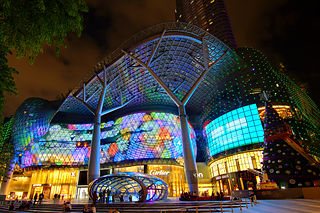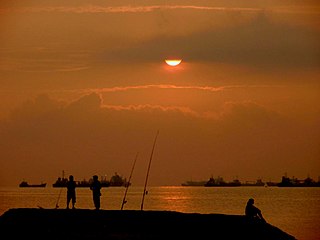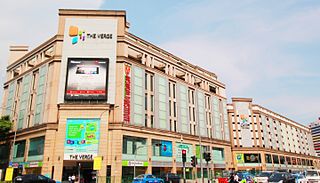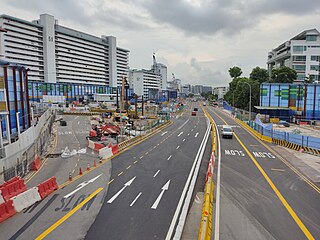
Punggol is a planning area and new town situated on the Tanjong Punggol peninsula in the North-East Region of Singapore. The town directly borders Sengkang to the south and shares riverine boundaries with the planning area of Seletar to the west and Pasir Ris to the east. Bounding the town to the north and north-east is the Straits of Johor, with Coney Island included as a part of the Punggol planning area.

Orchard Road, often known colloquially as simply Orchard, is a major 2.5 km (1.6 mi)-long road in the Central Area of Singapore. A famous tourist attraction, it is an upscale shopping area, with numerous internationally renowned department stores, shopping malls, restaurants, and coffeehouses located in its vicinity. It's a popular hotspot in Singapore, especially at night, attracting trendy urban youth.
Chinatown is a subzone and ethnic enclave located within the Outram district in the Central Area of Singapore. Featuring distinctly Chinese cultural elements, Chinatown has had a historically concentrated ethnic Chinese population.

Clarke Quay MRT station is an underground Mass Rapid Transit (MRT) station on the North East line (NEL) in Singapore. Situated along Eu Tong Sen Street near the junction of Merchant Road and North Canal Road, it is at the south of the Singapore River underneath The Central. The station serves Clarke Quay and Boat Quay, and other landmarks such as Hong Lim Park, The Riverwalk and the Swissotel Merchant Court.

East Coast Park is a beach and a park on the southeastern coast of Singapore. It stretches along the south of Marine Parade, Bedok and Tampines. It was opened in the 1970s, after the Singapore government had completed reclaiming land off the coast at Katong, from Kallang to Changi. Themed "Recreation for All", it not only serves the needs of communities in the east, other Singapore residents do also visit the park for sports, recreation, and food.

Ya Kun Kaya Toast, often colloquially known just as Ya Kun, is a Singaporean chain of mass-market, retro-ambience cafés selling toast products, soft-boiled eggs and coffee. Founded by Loi Ah Koon in 1944, Ya Kun remained a small family-run stall for decades, but has expanded rapidly since Loi's youngest son headed the business in 1999. The chain has over fifty outlets, mostly franchised, across 14 countries, and is a Singaporean cultural icon, known for its traditional brand identity and conservative, people-centric corporate culture.

Shenton Way is a major trunk road serving Singapore's Central Area and is most commonly known for the commercial skyscrapers flanking both sides of the road. The road is a one-way street that starts at the junction of Boon Tat Street, Raffles Quay and Commerce Street before ending at Keppel Road.

Lau Pa Sat, also known as Telok Ayer Market, is a historic building located within the Downtown Core in the Central Area of Singapore. It was first built in 1824 as a fish market on the waterfront serving the people of early colonial Singapore and rebuilt in 1838. It was then relocated and rebuilt at the present location in 1894. It is currently a food court with stalls selling a variety of local cuisine.

George Drumgoole Coleman, also known as George Drumgold Coleman, was an Irish civil architect who played an instrumental role in the design and construction of much of the civil infrastructure in early Singapore, after it was founded by Sir Stamford Raffles in 1819. Only a few of his buildings have survived in Singapore, most notably Armenian Church of Saint Gregory the Illuminator, Maxwell's House, and Caldwell House.

Tanjong Rhu, is a subzone within the planning area of Kallang, Singapore, as defined by the Urban Redevelopment Authority (URA). The perimeter of Tanjong Rhu is made up of Nicoll Highway in the north; Mountbatten Road and Fort Road in the east; East Coast Parkway (ECP) in the south; as well as Marina Channel and Kallang Basin in the west. Tanjong Rhu is the largest in terms of physical area among the nine subzones that make up Kallang.

Masjid Temenggong Daeng Ibrahim, also known as Masjid Diraja Telok Blangah, is a historical royal mosque that is located along 30 Telok Blangah Road in Telok Blangah within Bukit Merah, Singapore.

Balestier is a sub zone located in the planning area of Novena in the Central Region of Singapore. The main road, Balestier Road, links Thomson Road to Serangoon Road and the road continues on as Lavender Street. The area is home to rows of shophouses, such as the Sim Kwong Ho shophouses, the Balestier Art Deco shophouses, 412-418 Balestier Road, and 601-639 Balestier Road, low-rise apartments and commercial buildings as well as a shopping mall known as Shaw Plaza. Balestier also has another mall, Zhongshan Mall. There are several lighting and electrical shops along Balestier Road, which is also home to the Ceylon Sports Club and the Indian Association. The area is known for its food such as bak kut teh and chicken rice. In the area, there are several apartments, condominiums, and budget hotels.

The New 7th Storey Hotel was a demolished budget hotel once located on Rochor Road in the Downtown Core of Singapore.

The Verge, formerly Tekka Mall,, was the first and largest modern shopping mall at the Little India precinct in Singapore, being opened in 2003. The Verge had two buildings, the main building and Chill @ The Verge. It was located on the southern part of Little India, with the main building is located at the junction of Serangoon Road and Sungei Road and the Chill @ The Verge is located at the junction of Perak Road and Sungei Road. Both of the buildings were separated by Clive Street and the mall lies opposite of Tekka Centre across Serangoon Road. The complex was demolished in 2017 to make way for redevelopment after 14 years of operation, making it one of the youngest malls in Singapore to shut its doors.

The North–South Corridor (NSC), originally conceptualised as the North-South Expressway (NSE), is an under-construction expressway that will be the 11th of Singapore's network of expressways when completed. The North South Corridor will serve increasing traffic along the north-south corridor that is currently served by the Central Expressway (CTE). The 21.5 kilometres (13.4 mi) expressway is expected to cost about S$7.47 billion when fully completed in 2029 as North-South Corridor and will connect the East Coast Parkway (ECP) with the northern parts of Singapore.

The first market built in Taiping was in 1884 and 1885. Due to the rapid growth of population in the town, there were more markets that mushroomed around the town to provide basic facilities to the folks. Below are the major markets that were constructed in 1884 until the late 1960s.

Marine Terrace MRT station is a future underground Mass Rapid Transit station on the Thomson–East Coast line at the boundary of Marine Parade and Bedok planning areas, Singapore. Nearby residential areas such as Marine Terrace and Telok Kurau will be served.

Katong Park is neighborhood park located in Katong, Singapore at the junction of Meyer Road and Fort Road. Built in the 1930s above the buried remains of Fort Tanjong Katong, it was one of Singapore’s oldest parks with the first public bathing pagar and was highly popular with families during the weekends. After the coastal reclamation works in the 1970s, the park lost its sea frontage and declined greatly in popularity. It now remains as a small community park serving nearby residents.
Ellenborough Market, also known as Teochew Market, New Market, Sin Pa Sat and Pasar Bahru, was a market on Ellenborough Street along the Singapore River in Singapore. The market was demolished following a fire in 1968.

Orchard Road Market, also known as Tang Leng Pa Sat and Tanglin Pa Sat, was a market on Orchard Road in Singapore. Built in 1891, the market was demolished in 1982 to make way for redevelopments along Orchard Road.


















